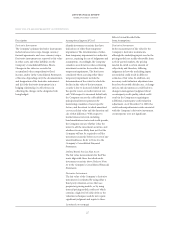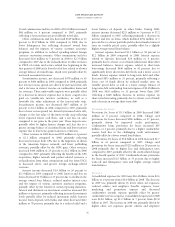American Express 2009 Annual Report Download - page 35
Download and view the complete annual report
Please find page 35 of the 2009 American Express annual report below. You can navigate through the pages in the report by either clicking on the pages listed below, or by using the keyword search tool below to find specific information within the annual report.
2009 FINANCIAL REVIEW
AMERICAN EXPRESS COMPANY
(a) See Glossary of Selected Terminology for the definitions of certain
key terms and related information.
(b) In the fourth quarter of 2008, the Company revised the time
period in which past due cardmember receivables in USCS are
written off to 180 days past due, consistent with applicable
regulatory guidance. Previously, receivables were written off when
360 days past billing. The net write-offs for 2008 include
approximately $341 million resulting from this write-off
methodology change, which is not reflected in the net write-off
rate for USCS. If the $341 million had been included in USCS
write-offs, the net write-off rate would have been 5.4 percent
for 2008.
(c) A cardmember account is considered 90 days past billing if
payment has not been received within 90 days of the
cardmember’s billing statement date. In addition, if the Company
initiates collection procedures on an account prior to the account
becoming 90 days past billing, the associated cardmember
receivable balance is considered as 90 days past billing. A
cardmember account becomes past due if payment is not received
within 30 days after the billing statement date.
(d) “Owned,” a GAAP basis measurement, reflects only cardmember
loans included on the Company’s Consolidated Balance Sheets.
(e) This amount includes reserves of $160 million for the year ended
December 31, 2009, that were removed in connection with
securitizations during the period. The offset is in the allocated
cost of the associated retained subordinated securities. This
amount also includes foreign currency translation adjustments.
The prior period included foreign currency translation and other
adjustments primarily related to the reclassification of certain
waived fee reserves to a contra-cardmember receivable.
(f) See below for calculations of net interest yield on cardmember
loans and the ratio of net interest income divided by average loans
presented on an owned basis. The Company believes net interest
yield on cardmember loans (on both an owned and managed
basis) is useful to investors because it provides a measure of
profitability of the Company’s cardmember loans portfolio.
(g) Includes on-balance sheet cardmember loans and off-balance
sheet securitized cardmember loans. The difference between the
“owned basis” (GAAP) information and “managed basis”
information is attributable to the effects of securitization
activities. Refer to the information set forth under USCS Selected
Financial Information for further discussion of the managed basis
presentation.
(h) This calculation includes elements of total interest income and
total interest expense that are not attributable to the cardmember
loan portfolio, and thus is not representative of net interest yield
on cardmember loans. The calculation includes interest income
and interest expense attributable to investment securities and
other interest-bearing deposits as well as to cardmember loans,
and interest expense attributable to other activities, including
cardmember receivables.
CALCULATION OF NET INTEREST YIELD ON
CARDMEMBER LOANS(a)
Years Ended December 31,
(Millions) 2009 2008
Owned Basis:
Net interest income $3,124 $3,646
Average loans (billions)$ 34.8 $ 47.6
Adjusted net interest income $3,392 $4,199
Adjusted average loans (billions)$ 34.9 $ 47.7
Net interest income divided by average loans 9.0% 7.7%
Net interest yield on cardmember loans 9.7% 8.8%
Managed Basis:
Net interest income(b) $5,977 $6,328
Average loans (billions)$ 63.8 $ 75.0
Adjusted net interest income $6,500 $6,881
Adjusted average loans (billions)$ 63.9 $ 75.0
Net interest yield on cardmember loans 10.2% 9.2%
(a) See Glossary of Selected Terminology for the definitions of certain
key terms and related information.
(b) Includes the GAAP to managed basis securitization adjustments
to interest income and interest expense as set forth under USCS
Selected Financial Information managed basis presentation.
The following discussions regarding Consolidated Results of
Operations and Consolidated Liquidity and Capital Resources
are presented on a basis consistent with GAAP unless
otherwise noted.
CONSOLIDATED RESULTS OF OPERATIONS FOR THE
THREE YEARS ENDED DECEMBER 31, 2009
The Company’s 2009 consolidated income from continuing
operations decreased $734 million or 26 percent to $2.1
billion and diluted EPS from continuing operations declined
$0.93 or 38 percent to $1.54. Consolidated income from
continuing operations for 2008 decreased $1.3 billion or 30
percent from 2007 and diluted EPS from continuing
operations for 2008 declined $0.97 or 28 percent from 2007.
The Company’s 2009 consolidated net income decreased
$569 million or 21 percent to $2.1 billion, and diluted EPS
decreased $0.78 or 34 percent to $1.54. Consolidated net
income for 2008 and 2007 was $2.7 billion and $4.0 billion,
respectively. Net income included losses from discontinued
operations of $7 million, $172 million and $114 million for
2009, 2008 and 2007, respectively.
The Company’s total revenues net of interest expense,
provisions for losses, and total expenses decreased by
approximately 14 percent, 8 percent and 14 percent,
respectively, in 2009. Assuming no changes in foreign
currency exchange rates from 2008 to 2009, total revenues net
of interest expense, provisions for losses and total expenses
decreased approximately 12 percent, 7 percent and 12
33
























